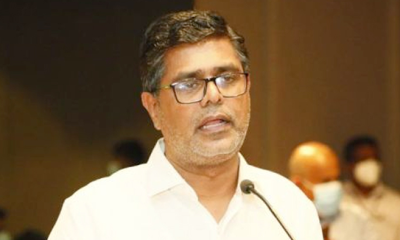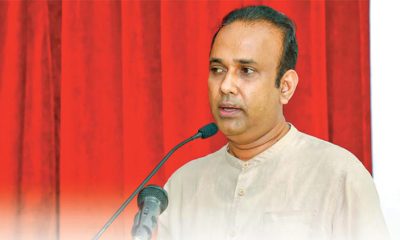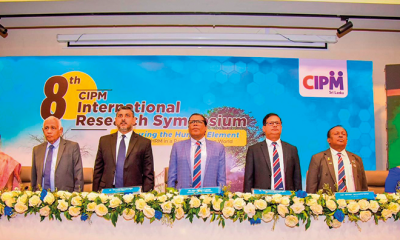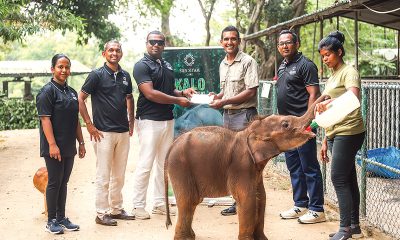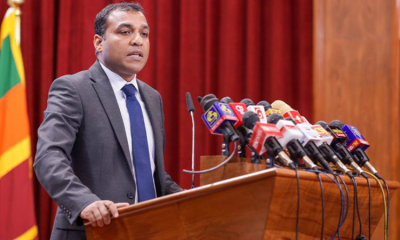Features
My take on the Olympics

“The most important thing in the Olympic Games is not winning but taking part; the essential thing in life is not conquering but fighting well.”
Pierre de Coubertin – Founder of International Olympic Games and its second president.
The 2020 Olympic Games started on Friday July 23 after more than one and a half years postponement due to the cursed coronavirus, which is stalking the Games with a couple of competitors proving positive. Sympathies are with the hosts Tokyo since holding the Games means much planning and organizing, money spent and work undertaken.
 We oldies were introduced to the Games early in life as we had to write essays about it; learnt its history in our Greek and Roman Civilization exam preparations and with interest kindled, were lucky to savour Duncan White’s success in hurdles and much later Susanthika Jayasinghe’s silver medal in the 200 m sprint at Sydney, maybe the greatest competed event. Plenty has been written about these two. As my title shows, I mean to write of matters and persons that have particularly interested me about this greatest of world sports events.
We oldies were introduced to the Games early in life as we had to write essays about it; learnt its history in our Greek and Roman Civilization exam preparations and with interest kindled, were lucky to savour Duncan White’s success in hurdles and much later Susanthika Jayasinghe’s silver medal in the 200 m sprint at Sydney, maybe the greatest competed event. Plenty has been written about these two. As my title shows, I mean to write of matters and persons that have particularly interested me about this greatest of world sports events.
Antecedents
The Olympic Games originated in Olympia, in the western Peloponnese in mainland Greece, in the 8th century BC and continued to the 4th century AD; dedicated to the chief of the Olympian Gods – Zeus. The date given for the first Games is 776 BC. Initially a one day event until 684 BC, they extended to three days, then to five. The events were running, long jump, shot put, javelin throw, boxing, pankration and equestrian events. Only men were allowed to compete and even as spectators and the competitors sported naked, it is said. The winners’ only reward was a wreath of olive leaves placed on the head. However, in the city states, many sportsmen were honoured with statues erected and hero status conferred.
The modern Olympics originated in 1894 with Baron Pierre de Coubertin being the principal mover of the founding of the International Olympic Games with its Olympic Charter outlining its structure and authority. The first re-enacted Games were held in Athens in 1896, soon to bifurcate to summer and winter competitions. Thousand of athletes from 200 countries around the world get together every four years, alternating between the Summer and Winter Olympics. Also introduced were the Palympic Games for disabled athletes and the Young Olympic Games for those between of 14 to 18 years of age.
The IOC has needed to adapt to a variety of economic, political and technological advancements. Thus the purely amateur status of participating athletes and sports people was gradually done away with and shifted to the acceptance of professionals. Another shift is towards corporate sponsorship and general commercialization of the Games.
The games were interrupted thrice being suspended in 1916, 1940 and 1944 due to World Wars I and II. There was also large scale boycotting of the Games by certain countries during the Cold War in 1980 and ‘84 and of course the latest postponement. We remember the worldwide shock as terrorism entered the Games Village in Munich in 1992 when eight Palestinian terrorists took 11 Israeli athletes hostage and later killed them. Security was naturally increased in subsequent Games, but a bomb exploded in the 1996 Atlanta, USA Games during a concert in Centennial Park. Security is extra high and now worried concern regards C19.
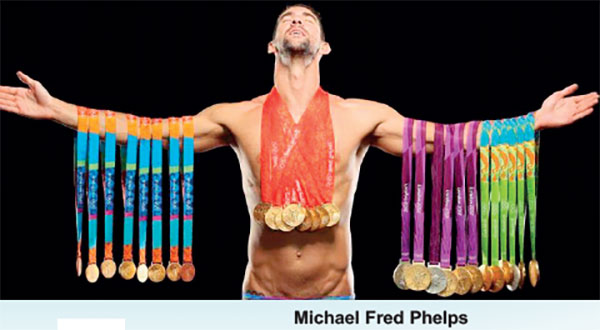
Essential trappings
I mean here the symbols and traditions associated with the Games; most being set down by Coubertin. The creed as decreed by Coubertin is “The important thing in life is not victory but combat; it is not to have vanquished but to have fought well.”
The slogan or motto of the Olympic Games was first used in 1924 and were the Latin words Citius, Altius, Fortius which mean Swifter, Higher, Stronger. During the recent International Olympic Committee’s session in Tokyo a fourth word was added ‘Together’. The fourth word is apt as the aim of the Olympics is to foster strong trusting relations and healthy competitiveness among athletes and thus spreading to nations.
The symbol of five linked rings in primary colours represents the five continents. The flag which has the Olympic symbol against a white background was first used in the Antwerp Games in 1920.
Most significant symbols are the lighting of the Olympic torch in Athens and carrying it across nations and oceans to the site of the current Games and lighting the flame holder within the stadium. This was eliminated this year with only a short run being enacted. A competing athlete from the home country takes the oath written by Coubertin, on behalf of all competitors, holding a corner of the Olympic Flag. It was first taken in Antwerp in 1920 by a Belgian fencer. It goes thus: “In the name of all the competitors I promise that we shall take part in these Olympic Games, respecting and abiding by the rules which govern them, in the true spirit of sportsmanship, for the glory of sport and honour of our teams.” It was updated in 1999 and used in Sydney in 2000, including the phrase “committing ourselves to sport without doping and without drugs.”

The opening ceremony and closing ceremonies are full of colour, razzmatazz but yet, solemn too. Hosting countries often justifiably showcase themselves. Most spectacular and rib-tickling with surprise was the opening ceremony of the London Summer Olympics in 2012 when, directed by irrepressible Danny Boyle, 007 James Bond (Daniel Craig) met the Queen, who said “Good Evening Mr Bond” and had him escort her to a helipad. The athletes and spectators gasped as she skydived from a helicopter with him direct to the Olympic Stadium. The Queen had cheekily wanted a speaking role for her appearance with Bond but it was a stuntman wearing a wig who skydived and actress Helen McCrory, who impersonated the Queen extricating herself from the parachute. Superbly sporty of the Queen who is known for her great impish humour, unlike her ancestor Queen Victoria who was not amused!
Great Olympians
I have selected three greats to mention here.
Florence Griffith Joyner (
1959-1998) a.k.a FloJo, tan skinned American track and field athlete dubbed ‘the fastest woman of all time’ who painted her six inch finger nails in multicolours and won first place in the 100 and 200 metres sprints in the Los Angeles Olympics in 1994 and repeated her gold winning performance in Seoul in 1988 adding gold for her 4X400 metres relay. She was accused of taking steroids but tests were negative. She won at other meets too, trained by her triple jump gold medalist husband Al Joyner. She attempted a comeback in 1996 but failed to win medals. In 1989 she instituted a foundation for underprivileged children. Hers was a spectacular life cut short when she was 38 years, dying of suffocation after a seizure due to a congenital abnormality in her blood vessels.
Haile

Gebrselassie, (1973 -) Ethiopian long distance track and field runner won two Olympic gold medals for 10,000 metres run – Atlanta 1996 and Sydney 2000, and four World Championship titles. He first ran in Ethiopian competitions barefoot having run all his life thus: 10 km to school and ten back in the highlands of Assisi and had one arm crooked holding his books and the other swinging free. That is how he always ran. He came from a desperately poor, motherless family and swore to help his country once success greeted him. Now a businessman he is an example to many. Ethiopian highlanders have dominated long distance and marathon races as their lungs are larger to inhale more air in the rarified atmosphere of the highlands.
Of famous swimmers Michael Fred Phelps (1985 -) is the greatest and most decorated Olympian of all time He won 28 medals and most golds – 23. He won eight golds at the 2008 Beijing Games and has participated in the Olympics in 2004 – Athens; Beijing – 2008; London – 2012; Rio de Janeiro – 2016.
I root for winner of all three Tennis Open championships and Wimbledon this year and one of the greatest players of all time: Novak Djokovic to win gold at the Olympics. He decided late to enter and I am sure he will win. Thus the Career Grand Slam for him this year, with only Rod Laver – 1962, 69; Maureen Connelly – 1953; Margaret Court – 1970; and Steffi Graf – 1988 who won all four Opens in previous years. Graf also won gold that year at the Olympics. Sure he still has to go beyond Federer, but trust his coolness to succeed.
Dawn Fraser said: “The Olympics remain the most compelling search for excellence that exists in sport, and maybe in life itself.” I add, it is the greatest teacher of clean competition and healthy inter-relationships.
Features
The heart-friendly health minister

by Dr Gotabhya Ranasinghe
Senior Consultant Cardiologist
National Hospital Sri Lanka
When we sought a meeting with Hon Dr. Ramesh Pathirana, Minister of Health, he graciously cleared his busy schedule to accommodate us. Renowned for his attentive listening and deep understanding, Minister Pathirana is dedicated to advancing the health sector. His openness and transparency exemplify the qualities of an exemplary politician and minister.
Dr. Palitha Mahipala, the current Health Secretary, demonstrates both commendable enthusiasm and unwavering support. This combination of attributes makes him a highly compatible colleague for the esteemed Minister of Health.
Our discussion centered on a project that has been in the works for the past 30 years, one that no other minister had managed to advance.
Minister Pathirana, however, recognized the project’s significance and its potential to revolutionize care for heart patients.
The project involves the construction of a state-of-the-art facility at the premises of the National Hospital Colombo. The project’s location within the premises of the National Hospital underscores its importance and relevance to the healthcare infrastructure of the nation.
This facility will include a cardiology building and a tertiary care center, equipped with the latest technology to handle and treat all types of heart-related conditions and surgeries.
Securing funding was a major milestone for this initiative. Minister Pathirana successfully obtained approval for a $40 billion loan from the Asian Development Bank. With the funding in place, the foundation stone is scheduled to be laid in September this year, and construction will begin in January 2025.
This project guarantees a consistent and uninterrupted supply of stents and related medications for heart patients. As a result, patients will have timely access to essential medical supplies during their treatment and recovery. By securing these critical resources, the project aims to enhance patient outcomes, minimize treatment delays, and maintain the highest standards of cardiac care.
Upon its fruition, this monumental building will serve as a beacon of hope and healing, symbolizing the unwavering dedication to improving patient outcomes and fostering a healthier society.We anticipate a future marked by significant progress and positive outcomes in Sri Lanka’s cardiovascular treatment landscape within the foreseeable timeframe.
Features
A LOVING TRIBUTE TO JESUIT FR. ALOYSIUS PIERIS ON HIS 90th BIRTHDAY

by Fr. Emmanuel Fernando, OMI
Jesuit Fr. Aloysius Pieris (affectionately called Fr. Aloy) celebrated his 90th birthday on April 9, 2024 and I, as the editor of our Oblate Journal, THE MISSIONARY OBLATE had gone to press by that time. Immediately I decided to publish an article, appreciating the untiring selfless services he continues to offer for inter-Faith dialogue, the renewal of the Catholic Church, his concern for the poor and the suffering Sri Lankan masses and to me, the present writer.
It was in 1988, when I was appointed Director of the Oblate Scholastics at Ampitiya by the then Oblate Provincial Fr. Anselm Silva, that I came to know Fr. Aloy more closely. Knowing well his expertise in matters spiritual, theological, Indological and pastoral, and with the collaborative spirit of my companion-formators, our Oblate Scholastics were sent to Tulana, the Research and Encounter Centre, Kelaniya, of which he is the Founder-Director, for ‘exposure-programmes’ on matters spiritual, biblical, theological and pastoral. Some of these dimensions according to my view and that of my companion-formators, were not available at the National Seminary, Ampitiya.
Ever since that time, our Oblate formators/ accompaniers at the Oblate Scholasticate, Ampitiya , have continued to send our Oblate Scholastics to Tulana Centre for deepening their insights and convictions regarding matters needed to serve the people in today’s context. Fr. Aloy also had tried very enthusiastically with the Oblate team headed by Frs. Oswald Firth and Clement Waidyasekara to begin a Theologate, directed by the Religious Congregations in Sri Lanka, for the contextual formation/ accompaniment of their members. It should very well be a desired goal of the Leaders / Provincials of the Religious Congregations.
Besides being a formator/accompanier at the Oblate Scholasticate, I was entrusted also with the task of editing and publishing our Oblate journal, ‘The Missionary Oblate’. To maintain the quality of the journal I continue to depend on Fr. Aloy for his thought-provoking and stimulating articles on Biblical Spirituality, Biblical Theology and Ecclesiology. I am very grateful to him for his generous assistance. Of late, his writings on renewal of the Church, initiated by Pope St. John XX111 and continued by Pope Francis through the Synodal path, published in our Oblate journal, enable our readers to focus their attention also on the needed renewal in the Catholic Church in Sri Lanka. Fr. Aloy appreciated very much the Synodal path adopted by the Jesuit Pope Francis for the renewal of the Church, rooted very much on prayerful discernment. In my Religious and presbyteral life, Fr.Aloy continues to be my spiritual animator / guide and ongoing formator / acccompanier.
Fr. Aloysius Pieris, BA Hons (Lond), LPh (SHC, India), STL (PFT, Naples), PhD (SLU/VC), ThD (Tilburg), D.Ltt (KU), has been one of the eminent Asian theologians well recognized internationally and one who has lectured and held visiting chairs in many universities both in the West and in the East. Many members of Religious Congregations from Asian countries have benefited from his lectures and guidance in the East Asian Pastoral Institute (EAPI) in Manila, Philippines. He had been a Theologian consulted by the Federation of Asian Bishops’ Conferences for many years. During his professorship at the Gregorian University in Rome, he was called to be a member of a special group of advisers on other religions consulted by Pope Paul VI.
Fr. Aloy is the author of more than 30 books and well over 500 Research Papers. Some of his books and articles have been translated and published in several countries. Among those books, one can find the following: 1) The Genesis of an Asian Theology of Liberation (An Autobiographical Excursus on the Art of Theologising in Asia, 2) An Asian Theology of Liberation, 3) Providential Timeliness of Vatican 11 (a long-overdue halt to a scandalous millennium, 4) Give Vatican 11 a chance, 5) Leadership in the Church, 6) Relishing our faith in working for justice (Themes for study and discussion), 7) A Message meant mainly, not exclusively for Jesuits (Background information necessary for helping Francis renew the Church), 8) Lent in Lanka (Reflections and Resolutions, 9) Love meets wisdom (A Christian Experience of Buddhism, 10) Fire and Water 11) God’s Reign for God’s poor, 12) Our Unhiddden Agenda (How we Jesuits work, pray and form our men). He is also the Editor of two journals, Vagdevi, Journal of Religious Reflection and Dialogue, New Series.
Fr. Aloy has a BA in Pali and Sanskrit from the University of London and a Ph.D in Buddhist Philosophy from the University of Sri Lankan, Vidyodaya Campus. On Nov. 23, 2019, he was awarded the prestigious honorary Doctorate of Literature (D.Litt) by the Chancellor of the University of Kelaniya, the Most Venerable Welamitiyawe Dharmakirthi Sri Kusala Dhamma Thera.
Fr. Aloy continues to be a promoter of Gospel values and virtues. Justice as a constitutive dimension of love and social concern for the downtrodden masses are very much noted in his life and work. He had very much appreciated the commitment of the late Fr. Joseph (Joe) Fernando, the National Director of the Social and Economic Centre (SEDEC) for the poor.
In Sri Lanka, a few religious Congregations – the Good Shepherd Sisters, the Christian Brothers, the Marist Brothers and the Oblates – have invited him to animate their members especially during their Provincial Congresses, Chapters and International Conferences. The mainline Christian Churches also have sought his advice and followed his seminars. I, for one, regret very much, that the Sri Lankan authorities of the Catholic Church –today’s Hierarchy—- have not sought Fr.
Aloy’s expertise for the renewal of the Catholic Church in Sri Lanka and thus have not benefited from the immense store of wisdom and insight that he can offer to our local Church while the Sri Lankan bishops who governed the Catholic church in the immediate aftermath of the Second Vatican Council (Edmund Fernando OMI, Anthony de Saram, Leo Nanayakkara OSB, Frank Marcus Fernando, Paul Perera,) visited him and consulted him on many matters. Among the Tamil Bishops, Bishop Rayappu Joseph was keeping close contact with him and Bishop J. Deogupillai hosted him and his team visiting him after the horrible Black July massacre of Tamils.
Features
A fairy tale, success or debacle

Sri Lanka-Singapore Free Trade Agreement
By Gomi Senadhira
senadhiragomi@gmail.com
“You might tell fairy tales, but the progress of a country cannot be achieved through such narratives. A country cannot be developed by making false promises. The country moved backward because of the electoral promises made by political parties throughout time. We have witnessed that the ultimate result of this is the country becoming bankrupt. Unfortunately, many segments of the population have not come to realize this yet.” – President Ranil Wickremesinghe, 2024 Budget speech
Any Sri Lankan would agree with the above words of President Wickremesinghe on the false promises our politicians and officials make and the fairy tales they narrate which bankrupted this country. So, to understand this, let’s look at one such fairy tale with lots of false promises; Ranil Wickremesinghe’s greatest achievement in the area of international trade and investment promotion during the Yahapalana period, Sri Lanka-Singapore Free Trade Agreement (SLSFTA).
It is appropriate and timely to do it now as Finance Minister Wickremesinghe has just presented to parliament a bill on the National Policy on Economic Transformation which includes the establishment of an Office for International Trade and the Sri Lanka Institute of Economics and International Trade.
Was SLSFTA a “Cleverly negotiated Free Trade Agreement” as stated by the (former) Minister of Development Strategies and International Trade Malik Samarawickrama during the Parliamentary Debate on the SLSFTA in July 2018, or a colossal blunder covered up with lies, false promises, and fairy tales? After SLSFTA was signed there were a number of fairy tales published on this agreement by the Ministry of Development Strategies and International, Institute of Policy Studies, and others.
However, for this article, I would like to limit my comments to the speech by Minister Samarawickrama during the Parliamentary Debate, and the two most important areas in the agreement which were covered up with lies, fairy tales, and false promises, namely: revenue loss for Sri Lanka and Investment from Singapore. On the other important area, “Waste products dumping” I do not want to comment here as I have written extensively on the issue.
1. The revenue loss
During the Parliamentary Debate in July 2018, Minister Samarawickrama stated “…. let me reiterate that this FTA with Singapore has been very cleverly negotiated by us…. The liberalisation programme under this FTA has been carefully designed to have the least impact on domestic industry and revenue collection. We have included all revenue sensitive items in the negative list of items which will not be subject to removal of tariff. Therefore, 97.8% revenue from Customs duty is protected. Our tariff liberalisation will take place over a period of 12-15 years! In fact, the revenue earned through tariffs on goods imported from Singapore last year was Rs. 35 billion.
The revenue loss for over the next 15 years due to the FTA is only Rs. 733 million– which when annualised, on average, is just Rs. 51 million. That is just 0.14% per year! So anyone who claims the Singapore FTA causes revenue loss to the Government cannot do basic arithmetic! Mr. Speaker, in conclusion, I call on my fellow members of this House – don’t mislead the public with baseless criticism that is not grounded in facts. Don’t look at petty politics and use these issues for your own political survival.”
I was surprised to read the minister’s speech because an article published in January 2018 in “The Straits Times“, based on information released by the Singaporean Negotiators stated, “…. With the FTA, tariff savings for Singapore exports are estimated to hit $10 million annually“.
As the annual tariff savings (that is the revenue loss for Sri Lanka) calculated by the Singaporean Negotiators, Singaporean $ 10 million (Sri Lankan rupees 1,200 million in 2018) was way above the rupees’ 733 million revenue loss for 15 years estimated by the Sri Lankan negotiators, it was clear to any observer that one of the parties to the agreement had not done the basic arithmetic!
Six years later, according to a report published by “The Morning” newspaper, speaking at the Committee on Public Finance (COPF) on 7th May 2024, Mr Samarawickrama’s chief trade negotiator K.J. Weerasinghehad had admitted “…. that forecasted revenue loss for the Government of Sri Lanka through the Singapore FTA is Rs. 450 million in 2023 and Rs. 1.3 billion in 2024.”
If these numbers are correct, as tariff liberalisation under the SLSFTA has just started, we will pass Rs 2 billion very soon. Then, the question is how Sri Lanka’s trade negotiators made such a colossal blunder. Didn’t they do their basic arithmetic? If they didn’t know how to do basic arithmetic they should have at least done their basic readings. For example, the headline of the article published in The Straits Times in January 2018 was “Singapore, Sri Lanka sign FTA, annual savings of $10m expected”.
Anyway, as Sri Lanka’s chief negotiator reiterated at the COPF meeting that “…. since 99% of the tariffs in Singapore have zero rates of duty, Sri Lanka has agreed on 80% tariff liberalisation over a period of 15 years while expecting Singapore investments to address the imbalance in trade,” let’s turn towards investment.
Investment from Singapore
In July 2018, speaking during the Parliamentary Debate on the FTA this is what Minister Malik Samarawickrama stated on investment from Singapore, “Already, thanks to this FTA, in just the past two-and-a-half months since the agreement came into effect we have received a proposal from Singapore for investment amounting to $ 14.8 billion in an oil refinery for export of petroleum products. In addition, we have proposals for a steel manufacturing plant for exports ($ 1 billion investment), flour milling plant ($ 50 million), sugar refinery ($ 200 million). This adds up to more than $ 16.05 billion in the pipeline on these projects alone.
And all of these projects will create thousands of more jobs for our people. In principle approval has already been granted by the BOI and the investors are awaiting the release of land the environmental approvals to commence the project.
I request the Opposition and those with vested interests to change their narrow-minded thinking and join us to develop our country. We must always look at what is best for the whole community, not just the few who may oppose. We owe it to our people to courageously take decisions that will change their lives for the better.”
According to the media report I quoted earlier, speaking at the Committee on Public Finance (COPF) Chief Negotiator Weerasinghe has admitted that Sri Lanka was not happy with overall Singapore investments that have come in the past few years in return for the trade liberalisation under the Singapore-Sri Lanka Free Trade Agreement. He has added that between 2021 and 2023 the total investment from Singapore had been around $162 million!
What happened to those projects worth $16 billion negotiated, thanks to the SLSFTA, in just the two-and-a-half months after the agreement came into effect and approved by the BOI? I do not know about the steel manufacturing plant for exports ($ 1 billion investment), flour milling plant ($ 50 million) and sugar refinery ($ 200 million).
However, story of the multibillion-dollar investment in the Petroleum Refinery unfolded in a manner that would qualify it as the best fairy tale with false promises presented by our politicians and the officials, prior to 2019 elections.
Though many Sri Lankans got to know, through the media which repeatedly highlighted a plethora of issues surrounding the project and the questionable credentials of the Singaporean investor, the construction work on the Mirrijiwela Oil Refinery along with the cement factory began on the24th of March 2019 with a bang and Minister Ranil Wickremesinghe and his ministers along with the foreign and local dignitaries laid the foundation stones.
That was few months before the 2019 Presidential elections. Inaugurating the construction work Prime Minister Ranil Wickremesinghe said the projects will create thousands of job opportunities in the area and surrounding districts.
The oil refinery, which was to be built over 200 acres of land, with the capacity to refine 200,000 barrels of crude oil per day, was to generate US$7 billion of exports and create 1,500 direct and 3,000 indirect jobs. The construction of the refinery was to be completed in 44 months. Four years later, in August 2023 the Cabinet of Ministers approved the proposal presented by President Ranil Wickremesinghe to cancel the agreement with the investors of the refinery as the project has not been implemented! Can they explain to the country how much money was wasted to produce that fairy tale?
It is obvious that the President, ministers, and officials had made huge blunders and had deliberately misled the public and the parliament on the revenue loss and potential investment from SLSFTA with fairy tales and false promises.
As the president himself said, a country cannot be developed by making false promises or with fairy tales and these false promises and fairy tales had bankrupted the country. “Unfortunately, many segments of the population have not come to realize this yet”.
(The writer, a specialist and an activist on trade and development issues . )




